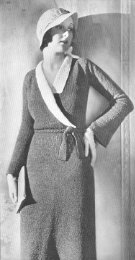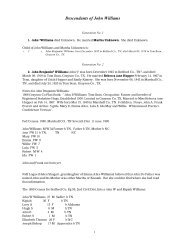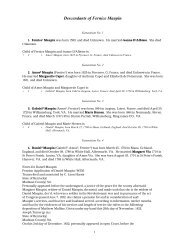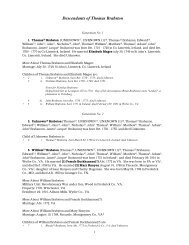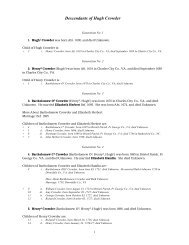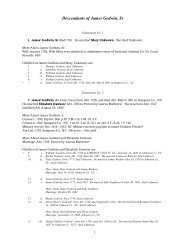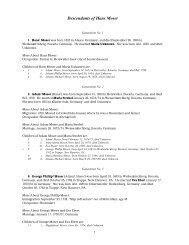Blankenship - Cemetarian
Blankenship - Cemetarian
Blankenship - Cemetarian
You also want an ePaper? Increase the reach of your titles
YUMPU automatically turns print PDFs into web optimized ePapers that Google loves.
other men (all presumably indentured servants) and 70 African slaves were imported or their passages<br />
paid for by Richard Kennon in the year 1686. We further know that Robert Paggin (in London,<br />
England), and Colonel John Pleasants of Bermuda Hundred, Viginia were Kennon's business partners<br />
who presumably arranged for the passage of the indentured servants as well as the slaves.<br />
Additonally, it is known that during mid- to late-1685 Richard Kennon began construction of his<br />
plantation home on Conjurer's Neck (just northeast of present day Colonial Heights, Virginia). I have<br />
made the presumption that Kennon was seeking skilled workmen to build his home and perhaps had<br />
Ralph Blankinship recruited in England as a craftsman to become one of his permanent staff.<br />
Blacksmiths were highly valued craftsmen of that era. We know that Ralph came to America as an<br />
indentured servant because the historical records say that Kennon imported <strong>Blankenship</strong> which means<br />
that he paid for his passage across the Atlantic Ocean. I further presume that Ralph Blankinship had<br />
some metal smithing or metal foundry skills because of the fairly large amount of scrap metal (brass,<br />
pewter and both worked and raw iron) accounted for at the time of his death. I also note the fact that<br />
there was an iron mining operation a short distance southeast of his 200 acre land holding located one<br />
mile southeeast of present day Chesterfield, Virginia. One other fact plays into my thinking and that is<br />
the fact that the first iron smelting operation in America was only a few miles north of where Ralph<br />
Blankinship lived. I'm also aware that there are older iron smelting foundries near his home in<br />
Hernrico County, VA and that the first iron mining in America occured in Henrico County. The last<br />
item for consideration is presented elsewhere in on this "<strong>Blankenship</strong> Origins" web site and that is the<br />
fact that sometime around 1694 a court action was initiated against Ralph <strong>Blankenship</strong> for cutting<br />
down timber on another man's land. The amount the man was attempting to sue for was 100 English<br />
pounds, or about $13,000 in today's money. The court eventually ruled that the land where the lumber<br />
was cut was swamp land and that there were questions concerning the succession of land rights when<br />
two partners predeceased the claimant. Ralph apparently paid nothing. However, the large amount of<br />
timber he cut down suggests to most people that he may have used it to produce charcoal. Charcoal<br />
production for metal smelting in Cumberland, England during the 1600's was one of the likely reasons<br />
the landscape was reported denuded and barren. While we don't know what Ralph did with all that<br />
timber, it must have been a formidable labor and not done in vain. This fact is just another piece of the<br />
unsolved puzzle of what trade or profession the immigrant Ralph Blankinship engaged in during his<br />
lifetime. If we could only excavate in the area of his known residence circa 1700 located one mile<br />
southeast of Chesterfield we might possibly discover the remains of charcoal from a private smelting<br />
operation. The charcoal might then be carbon dated and conclusions drawn. But alas, I'm told that a<br />
small strip mall of some sort with a large parking lot exists today where Ralph and Martha presumably<br />
once lived at the end of the 17th century. Their homestead location is precisely defined elsewhere at<br />
this web site.<br />
In spite of all these assumptions there is no solid proof to link Ralph to one particular trade or<br />
profession. However, the total absence of farming implements listed on his death inventory of goods,<br />
such as we find in the inventories of his sons, suggests to me that he was not a farmer. He therefore<br />
must have been a skilled tradesman. Because he died young, at age 54, may further suggest that he<br />
worked in a harsh trade such as metal smelting where mercury, arsenic and other noxious chemicals<br />
are used. Because Richard Kennon paid a quit rent for Ralph Blankinship sometime before his death<br />
(on at least on one or more occasions), this further suggests to me that somehow Ralph was beholden<br />
to Kennon. In fact, when Ralph died Kennon's heirs, most likely his wife, was still holding an<br />
outstanding debt owed by Ralph to Richard Kennon. A court action was recorded regarding the<br />
collection of the monies owed in tobacco equivalent to cancel the debt paid for the quit rent. [NOTE: A<br />
quit rent is money paid so that one does not have to perform a particular service, such as military<br />
service. In Colonial Virgina men were obligated to serve in the local militia which acted as as a defense<br />
force protecting settlers from Indian attacks, which were quite common then. These Indian attack<br />
persisted until the early 1760's when a Viriginia militia force was assembled by the Virignia Governor<br />
to fight the Indians that were becoming a serious threat. There is an historical record of <strong>Blankenship</strong>s<br />
being called to service in that rather lengthy engagement which preceeded the War of Revolution by<br />
about 15 years. We therefore can proudly say that <strong>Blankenship</strong>s have participated in every American<br />
war, including the Indian war of Central Virginia during the 1760's.]<br />
2




